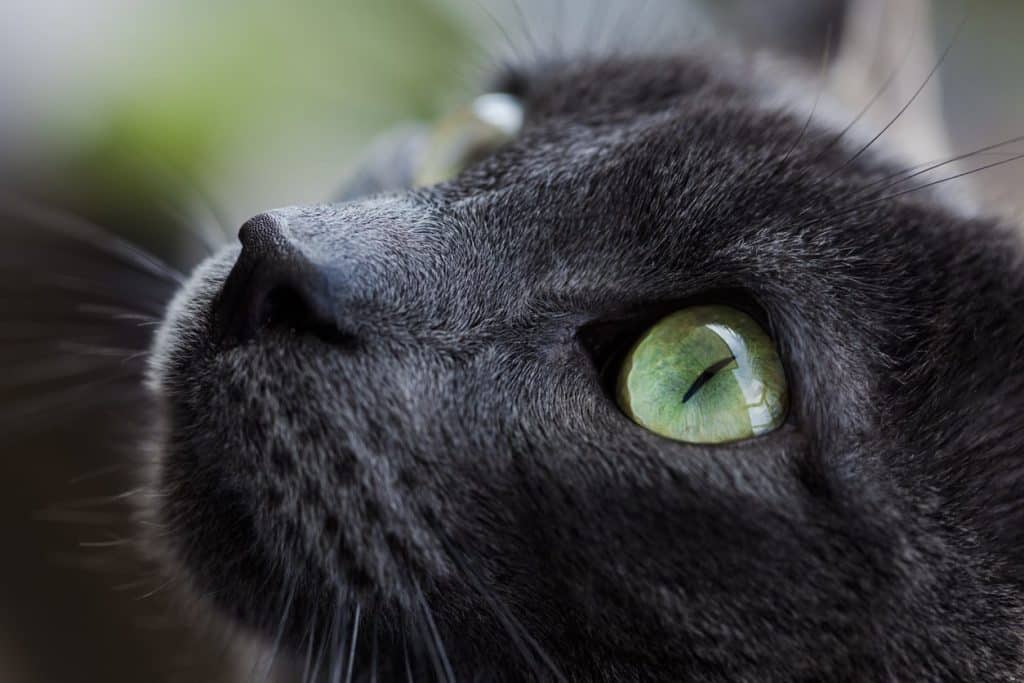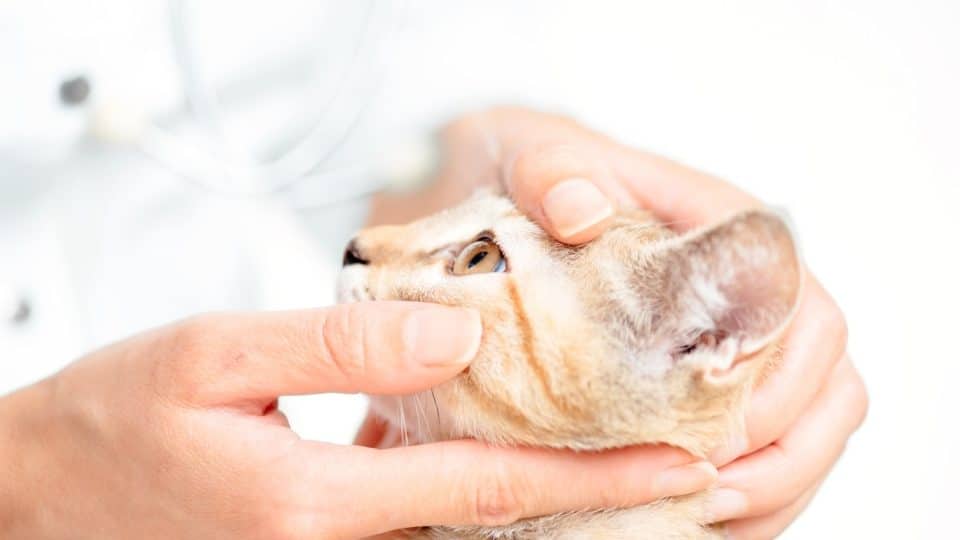- Not a substitute for professional veterinary help.
Anisocoria, or different pupil sizes, is a symptom of many eye problems in cats. Dr. Ann Bosiack, DVM, MS, Diplomate ACVO at Animal Eye Care of Richmond, says anisocoria isn’t common. In some cases, anisocoria in cats may resolve on its own, but it’s always a good idea to speak with your vet about any new symptoms in your cat that are out of the ordinary. If it comes on suddenly or your cat shows neurological signs, such as seizures, circling, or head tilt, should see a vet as soon as possible.
Below, learn more about what causes anisocoria in cats, symptoms to look out for, and what treatment options are available.
What Is Anisocoria & What Causes It?
Dr. Bosiack says anisocoria is usually a symptom of other health, ocular, or neurological conditions. Unless there are other signs to anisocoria, she says it would be difficult for a pet parent to determine what’s causing their cat’s different pupil sizes without speaking to a vet.
Eye surface issues (e.g. uveitis)
Various ocular disorders, such as blunt trauma, cataracts, and corneal ulceration, may cause different pupil shapes associated with conditions like anterior uveitis. If both eyes are affected, this might be a sign of an infectious or autoimmune disease or metastatic cancer.
Optic nerve issues
Optic nerve issues, sometimes due to viral infections like feline leukemia virus (FeLV), may also cause anisocoria in cats. Cats with optic neuritis may show signs of blindness, slow pupillary light reflexes, or mydriasis, aka dilated pupils.
Spastic pupil syndrome
Spastic pupil syndrome can result in anisocoria that resolves on its own and returns. It may even switch between eyes that it affects and can be linked to cats who test positive for FeLV. However, this isn’t always the case. A co-infection with Bartonella henselae infection and Sarcocystis sp. may also lead to a change in pupil sizes.
Feline Glaucoma
Like humans, cats can also develop glaucoma. Feline glaucoma has several different causes depending on whether it’s primary or secondary glaucoma. These signs include the following.
- Cloudy eyes
- Dilated pupils
- Squinting
- An enlarged eye
- Vision loss
Horner’s Syndrome
Horner’s Syndrome is a neurological disorder that affects a cat’s facial features on one side of their face, primarily their eye, including the pupil, eyelid, and eyeball. Signs of Horner’s Syndrome include:
- Shrinking of the pupil
- Cherry eye
- Sunken eye
- Upper eyelid drooping
Iris atrophy
Iris atrophy is a rare condition that can develop due to age, chronic uveitis, glaucoma, or trauma. Symptoms are similar to optic neuritis (e.g. different pupil sizes and slow pupillary light reflexes) accompanied by thinning of the iris and a misshapen pupil.
Retinal detachment
Health conditions and diseases in cats, such as high blood pressure, feline infectious peritonitis, and feline leukemia can result in retinal detachment along with inflammation in the choroid and retina. Signs of retinal detachment include:
- Fixed dilated pupils
- Different pupil sizes
- Bleeding within the eye
- Vision loss
What are Other Symptoms of Vision Problems in Cats?
Dr. Whitney Miller, DVM, MBA, DACVPM, Chief Veterinarian at Petco, says the following symptoms may indicate a cat is experiencing vision problems other than anisocoria.
- Squinting
- Keeping one eye closed
- Scratching or rubbing the eyes
- Discharge
- Swelling
- Redness
- Walking into furniture or their surroundings
- Watery eyes
Additionally, a cat may be hesitant to jump, unwilling to go up or down stairs, or easily startled, Dr. Bosiack notes. Lastly, Dr. Miller explains that differently dilated pupils are often the first symptom of anisocoria pet parents notice.
Is Anisocoria in Cats Serious?
“There are a variety of reasons your cat’s pupils may be different sizes, and many can be very serious and should be approached with urgency,” Dr. Miller says.
If your cat’s anisocoria comes on suddenly, Dr. Miller says it should be treated as an emergency and recommends contacting your vet immediately. Though the symptom of different pupil sizes won’t lead to permanent vision loss on its own, she says the underlying cause can result in serious damage to your cat’s vision.

iStock/Sandra Milena Valero Orjuela
How Does a Vet Diagnose Anisocoria?
When first evaluating a cat with anisocoria, Dr. Miller says many eye exams will consist of three tests:
- the Schirmer tear test
- a fluorescein stain
- an intraocular pressure test
Along with these three basic eye tests, your vet will examine your cat’s vision and nerve functions. They may also test for other potential causes with a blood panel and imaging, such as X-rays, due to the serious nature of eye abnormalities, she says.
Because general anesthesia can change how pupils react to light, Dr. Miller says your vet will try to evaluate your cat while they’re awake first. There are some instances, such as if your kitty shows signs of fear, anxiety, or stress, or a test—such as an MRI—requires special handling when sedation or anesthesia is recommended.
Furthermore, Dr. Miller says the time a diagnosis takes varies depending on the underlying cause. Certain causes like glaucoma, eye injuries, and some metabolic causes can be diagnosed on the same day. However, if the frontline diagnostics can’t determine the cause, your vet may send tests to a lab, which may take up to a week for results.
Your vet may refer you to a specialist, such as an ophthalmologist or internal medicine specialist, if it’s a complicated or mysterious case of anisocoria.
How Treatable Is Anisocoria in Cats?
As we’ve mentioned, most conditions causing anisocoria aren’t life-threatening. However, Dr. Miller says treatment is necessary to prevent possible vision loss. The following are the most common causes of anisocoria in cats and the available treatments.
| Anisocoria Causes | Possible Treatments |
| Uveitis | Typically treatable with topical or oral medication; low chance of permanent blindness when treated promptly |
| Neurological causes/optic nerve issues | Varies based on specific type of issue; requires medication, surgery in some cases; low-medium chance of permanent blindness when treated |
| Spastic pupil syndrome | Can be difficult to treat due to feline leukemia; treatment given is to address the underlying issue; low chance of permanent blindness when treated |
| Feline glaucoma | Typically treatable with medication; medium-high chance of permanent blindness if not treated due to underlying cause |
| Horner’s Syndrome | May clear on its own, but important to watch and understand the underlying cause; can be treated with medication and surgery in some cases; low chance of permanent blindness when treated |
| Iris atrophy | Not treatable; any treatment given is to address the underlying disease; very low chance of permanent blindness when treated |
| Retinal Disease | Most are treatable; requires medication; low-medium chance of permanent blindness when treated |
Dr. Bosiack says that while not all causes can be treated, many can, and some resolve on their own. She adds that cats who experience blindness due to the underlying cause of anisocoria have a fairly good chance of recovery, although it depends on the root cause.



